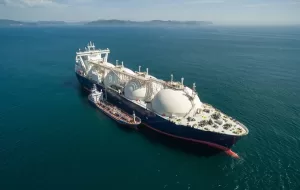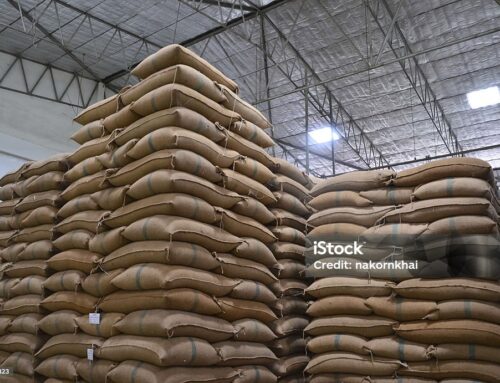
Liquefied Natural Gas (LNG) has emerged as a pivotal energy source in the 21st century, bridging geographical distances and fueling diverse sectors across the globe. This super-cooled form of natural gas, reduced to approximately 1/600th of its original volume, allows for efficient transportation across oceans, transforming natural gas into a truly global commodity. From powering industries to heating homes, LNG plays an increasingly crucial role in the world’s energy mix and economic development. Let’s delve into the multifaceted world of LNG, exploring its extraction, trade, applications, economic significance, environmental considerations, and the intricate web of factors that shape its global trajectory.
Unearthing the Source: The Mining Process of LNG
While we often speak of “LNG mines,” it’s important to clarify that LNG itself isn’t mined. Rather, it’s the result of a sophisticated process applied to natural gas extracted from underground reservoirs or associated with crude oil production. These natural gas reserves are found in various geological formations across the world. The journey from raw natural gas to liquefied form involves several key stages:
-
Extraction: Natural gas is extracted through wells drilled into underground formations. This raw gas is a mixture of hydrocarbons, primarily methane (CH₄), along with other components like ethane, propane, butane, nitrogen, carbon dioxide, and water vapour.
-
Processing: The extracted natural gas undergoes extensive processing to remove impurities that can cause problems during liquefaction or damage equipment. This involves:
- Acid Gas Removal: Removing carbon dioxide (CO₂) and hydrogen sulfide (H₂S), which are corrosive.
- Water Removal: Dehydrating the gas to prevent ice formation at cryogenic temperatures.
- Heavy Hydrocarbon Removal: Separating propane, butane, and other heavier hydrocarbons, which can solidify during liquefaction.
- Nitrogen Removal: Reducing nitrogen content to improve the efficiency of the liquefaction process.
-
Liquefaction: This is the core of the LNG production process. The purified natural gas is cooled to approximately -162°C (-260°F) at near-atmospheric pressure. This extreme cooling causes the gas to condense into a liquid state, significantly reducing its volume. Various refrigeration technologies are employed for this purpose, including cascade refrigeration, propane pre-cooled mixed refrigerant (C3MR), and dual mixed refrigerant (DMR) processes.
-
Storage: The liquefied natural gas is then stored in specialised cryogenic tanks designed to maintain its extremely low temperature and prevent boil-off (evaporation). These tanks are typically double-walled with insulation and a vapour barrier.
-
Loading: Finally, the LNG is pumped from the storage tanks into specially designed LNG carriers – large ships with insulated tanks – for transportation across the seas.
Global Hotspots: Regions with Liquefied Natural Gas Mines (Production Facilities)
While the term “mines” is inaccurate, several regions across the globe boast significant natural gas reserves and the infrastructure for LNG production. These include:
- Qatar: Holds some of the world’s largest natural gas reserves and is a leading LNG exporter, with massive production facilities.
- Australia: Possesses substantial offshore gas fields and has invested heavily in LNG export terminals, particularly in Western Australia and Queensland.
- United States: The shale gas revolution has propelled the US into a major LNG exporter, with facilities along the Gulf Coast and in Alaska.
- Malaysia: A long-standing player in the LNG market, with significant production from offshore gas fields.
- Indonesia: Another key LNG producer in Southeast Asia, with a history of exporting to the region and beyond.
- Nigeria: A significant LNG producer in Africa, leveraging its substantial natural gas reserves.
- Algeria: A major gas producer in North Africa with established LNG export infrastructure.
- Russia holds the world’s largest natural gas reserves and has several LNG projects, particularly in the Arctic region.
- Norway: A significant gas producer in Europe, with some LNG export capacity.
- Canada: Has emerging LNG export projects, particularly on the west coast.
This list is not exhaustive, and new LNG production facilities are continuously being developed in various parts of the world as demand grows.
The Top Players: Leading LNG Importers and Exporters
The global LNG trade is characterised by a dynamic interplay between major importing and exporting nations. Understanding these flows is crucial to grasping the commodity’s significance.
Top 10 LNG Exporters (approximate, subject to change):
- Australia
- Qatar
- United States
- Malaysia
- Indonesia
- Nigeria
- Algeria
- Russia
- Norway
- Trinidad and Tobago
Top 10 LNG Importers (approximate, subject to change):
- Japan
- China
- South Korea
- India
- Taiwan
- United Kingdom
- Spain
- France
- Brazil
- Thailand
These rankings can shift based on economic growth, energy policies, and geopolitical events. However, they highlight the significant demand for LNG in Asia, Europe, and parts of South America.
Versatile Applications: Industries Reliant on LNG
LNG’s clean-burning nature and portability make it a valuable fuel source for a wide range of industries:
- Power Generation: LNG is a crucial fuel for gas-fired power plants, providing a reliable and relatively cleaner alternative to coal for electricity generation. It is vital in ensuring energy security and supporting the transition to lower-carbon power systems.
- Industrial Sector: Many energy-intensive industries utilise LNG for process heating, steam generation, and as a feedstock for chemical production (e.g., fertilisers, methanol). These industries include manufacturing, refining, and petrochemicals.
- Residential and Commercial Heating: In regions with established gas distribution networks or access to LNG regasification terminals, LNG is used for heating homes, commercial buildings, and water.
- Transportation: LNG is increasingly being adopted as a fuel for heavy-duty vehicles (trucks, buses), marine vessels, and even some locomotives. Its lower emissions compared to traditional fuels make it an attractive option for reducing the environmental impact of transportation.
- Small-Scale Applications: LNG can be regasified and used in off-grid locations for power generation, heating, and industrial processes, providing energy access to remote communities and businesses.
Fueling Progress: Why LNG is Essential for Economic Development
LNG plays a significant role in fostering economic development in several ways:
- Energy Security and Diversification: For importing nations, LNG provides a crucial alternative to relying solely on pipeline gas or other energy sources. This diversification enhances energy security and reduces vulnerability to supply disruptions.
- Industrial Growth: Reliable and affordable energy is a fundamental requirement for industrial development. LNG provides a stable fuel source for manufacturing and other energy-intensive industries, supporting economic expansion and job creation.
- Infrastructure Development: The LNG value chain, from production facilities to regasification terminals and transportation infrastructure, requires significant investment, stimulating economic activity and creating employment opportunities.
- Trade and Revenue Generation: For exporting nations, LNG exports generate substantial revenue, contributing to national income and supporting economic growth. The LNG trade also fosters international partnerships and strengthens diplomatic ties.
- Access to Cleaner Energy: Compared to coal and some oil products, natural gas combustion produces lower levels of greenhouse gases and air pollutants. LNG can therefore contribute to a cleaner energy mix and support sustainable economic development.
- Flexibility and Market Responsiveness: The ability to transport LNG by sea allows for greater flexibility in responding to regional energy demands and price fluctuations, contributing to a more stable and efficient global energy market.
The Environmental Equation: Impacts of LNG Mining and Production
While often touted as a cleaner alternative to coal and oil, the LNG value chain is not without its environmental impacts:
- Greenhouse Gas Emissions: The extraction, processing, liquefaction, transportation, and regasification of natural gas all contribute to greenhouse gas emissions, primarily methane (a potent greenhouse gas) and carbon dioxide. Methane leaks during production and transportation are a significant concern.
- Land Use and Habitat Disturbance: The development of gas fields, pipelines, and LNG facilities can lead to habitat loss, deforestation, and disruption of ecosystems, particularly in sensitive areas.
- Water Consumption and Discharge: LNG production and processing require significant amounts of water for cooling and other processes. Discharge of wastewater can impact local water resources if not properly managed.
- Noise and Air Pollution: Compressor stations, liquefaction plants, and LNG carriers can generate noise and localised air pollution, affecting nearby communities and ecosystems.
- Risk of Accidents: Accidents during drilling, transportation, or at LNG facilities can lead to spills, fires, and explosions, posing risks to human health and the environment.
- Fracking Concerns: In some regions, hydraulic fracturing (“fracking”) is used to extract natural gas, which raises concerns about water contamination, induced seismicity, and methane leakage.
Price Volatility: Factors Influencing LNG Market Fluctuations
LNG prices in global markets are subject to significant fluctuations driven by a complex interplay of factors:
- Supply and Demand Dynamics: Basic economic principles apply. Increased demand due to cold winters, industrial growth, or power shortages can drive prices up, while increased supply from new projects or lower demand can lead to price declines.
- Geopolitical Events: Political instability, conflicts, and sanctions in major producing or consuming regions can disrupt supply chains and significantly impact prices.
- Weather Patterns: Extreme weather events, such as heatwaves (increasing power demand for cooling) or severe winters (increasing heating demand), can lead to sharp price spikes.
- Storage Levels: The amount of natural gas in storage in key consuming regions can influence prices. Low storage levels tend to push prices higher during periods of high demand.
- Pipeline Gas Prices: In regions with established pipeline infrastructure, LNG prices can be influenced by the price of pipeline gas, often with a degree of indexation.
- Oil Prices: Historically, LNG prices in some regions have been linked to crude oil prices through long-term contracts. While this linkage is weakening in some markets, oil price movements can still have an indirect impact.
- Shipping Costs: The cost of transporting LNG can fluctuate based on vessel availability, fuel prices, and geopolitical risks affecting shipping routes.
- Regulatory Changes: Government policies related to energy production, consumption, and environmental regulations can influence LNG prices.
- Market Sentiment and Speculation: Trader expectations and speculative activities can also contribute to price volatility in the short term.
Innovation in LNG: Extraction and Recycling Advancements
The LNG industry is continuously evolving, with technological advancements focused on improving efficiency, reducing costs, and minimising environmental impact:
- Enhanced Gas Recovery Technologies: Innovations in drilling techniques, reservoir management, and enhanced gas recovery (EGR) methods aim to maximise the extraction of natural gas from existing fields.
- Floating LNG (FLNG) Facilities: These offshore platforms combine gas processing, liquefaction, and storage, allowing for the development of remote offshore gas fields that were previously uneconomical to exploit. FLNG can also reduce the environmental footprint associated with onshore infrastructure.
- Smaller-Scale LNG (SSLNG) Technologies: Development of smaller liquefaction plants and specialised carriers enables the supply of LNG to remote areas and for niche applications like fueling ships and trucks.
- Boil-Off Gas (BOG) Management: Advanced technologies are being implemented to capture and reliquefy boil-off gas from LNG storage tanks and carriers, reducing methane emissions and improving efficiency.
- Carbon Capture and Storage (CCS): Research and development are underway to integrate CCS technologies with LNG production facilities to capture and store carbon dioxide emissions, aiming to reduce the carbon footprint of LNG.
- Waste Heat Recovery: Efforts are focused on recovering waste heat from liquefaction processes to improve energy efficiency and reduce overall energy consumption.
- LNG Regasification Cold Energy Utilisation: The regasification of LNG releases significant amounts of “cold energy.” Innovative technologies are being developed to utilise this cold energy for applications like refrigeration, cold storage, and even power generation, improving the overall energy efficiency of the LNG import process.
Geopolitical Currents: Impact on LNG Trade
The LNG trade is deeply intertwined with geopolitical factors, influencing supply security, pricing, and investment decisions:
- Political Stability and International Relations: Stable political relations between exporting and importing countries are crucial for ensuring a reliable LNG supply. Disputes, sanctions, or political instability can disrupt trade flows and lead to price volatility.
- Security of Supply Routes: The security of maritime shipping lanes is paramount for LNG trade. Geopolitical tensions or conflicts in key shipping regions can pose risks to LNG transportation and increase costs.
- Energy Security Policies: Governments in importing nations often prioritise energy security, leading to strategic decisions about LNG import diversification and the development of long-term supply contracts.
- Competition for Resources: Competition among importing nations for access to LNG supplies can influence prices and trade agreements.
- Transit Agreements: For pipeline gas, transit agreements between countries are critical. While LNG offers more flexibility, port access and maritime law are still important considerations.
- International Partnerships and Investments: LNG projects often involve significant international investment and partnerships, which can be influenced by geopolitical considerations and investment climates.
- The Role of State-Owned Enterprises: In many exporting and importing countries, state-owned energy companies play a significant role in the LNG trade, making government policies and international relations key drivers.
Comparing Footprints: LNG Extraction vs. Other Fossil Fuels
When comparing the environmental impacts of LNG extraction to other fossil fuels, several points emerge:
- Greenhouse Gas Intensity: While all fossil fuels contribute to greenhouse gas emissions, natural gas combustion generally produces less carbon dioxide per unit of energy compared to coal and oil. However, methane leakage throughout the LNG value chain can offset some of these benefits, as methane is a much more potent greenhouse gas in the short term.
- Air Pollutants: Burning natural gas produces significantly lower levels of sulfur oxides (SOx), nitrogen oxides (NOx), and particulate matter compared to coal and heavy fuel oil, leading to better air quality.
- Water Usage: Fracking for natural gas can be water-intensive, raising concerns in water-scarce regions. Conventional gas extraction may have lower water requirements compared to some oil extraction methods, like enhanced oil recovery.
- Land Disturbance: The footprint of gas wells and pipelines can be substantial, similar to oil and coal mining infrastructure. However, the specific impacts depend on the geological conditions and extraction methods used.
- Risk of Spills: LNG spills at sea can have localised environmental impacts, but they do not persist in the environment as long as oil spills. However, the rapid vaporisation of LNG can create flammable vapour clouds.
- Waste Generation: Coal mining generates significant amounts of solid waste. LNG production generates less solid waste but produces wastewater that needs careful management.
Overall, while natural gas and LNG offer advantages in terms of certain air pollutants and potentially lower carbon dioxide emissions at the point of combustion, the entire lifecycle, including methane leakage, needs careful consideration when comparing their environmental footprint to other fossil fuels.
Navigating Regulations: Addressing Environmental and Safety Concerns
Different countries employ a range of regulations to address the environmental and safety concerns associated with the LNG industry:
- Environmental Impact Assessments (EIAS): Mandatory EIAS are often required before the development of LNG projects to assess potential environmental impacts and propose mitigation measures.
- Emissions Standards: Regulations may set limits on greenhouse gas emissions, air pollutants, and wastewater discharge from LNG facilities.
- Safety Standards: Stringent safety regulations govern the design, construction, operation, and maintenance of LNG facilities and carriers to prevent accidents. These often include specific requirements for cryogenic handling, fire safety, and emergency response.
- Pipeline Safety Regulations: Regulations govern the construction, operation, and inspection of natural gas pipelines to ensure their integrity and prevent leaks.
- Water Management Regulations: Rules may be in place to control water usage and wastewater discharge from LNG facilities and fracking operations.
- Land Use Planning and Zoning: Regulations may restrict the location of LNG facilities in sensitive ecological areas or near populated areas.
- Methane Leakage Monitoring and Control: Increasingly, regulations are focusing on monitoring and reducing methane emissions throughout the natural gas and LNG supply chain.
- Carbon Capture and Storage Incentives: Some countries offer incentives or mandates for the development and deployment of CCS technologies in industrial sectors, including LNG production.
The specific regulations vary significantly between countries and are often influenced by local environmental conditions, public concerns, and the maturity of the LNG industry in that region.
The Role of Treaties: Ensuring Stability in the LNG Market
International treaties and agreements play a crucial role in fostering stability and predictability in the global LNG market:
- Bilateral and Multilateral Trade Agreements: These agreements can include provisions related to energy trade, investment protection, and dispute resolution, contributing to a more stable and predictable environment for LNG trade between participating countries.
- International Maritime Law: Conventions governing maritime safety, environmental protection, and the transport of dangerous goods (including LNG) ensure safe and responsible shipping practices.
- Energy Charters and Agreements: Some international agreements, like the Energy Charter Treaty, aim to promote energy security, investment, and trade, although their effectiveness and universality are subjects of ongoing debate.
- Climate Change Agreements: International agreements like the Paris Agreement, while not directly regulating LNG trade, influence the long-term demand for natural gas as a lower-carbon alternative to coal and oil, thus indirectly impacting the LNG market.
- Industry Standards and Best Practices: International industry organisations and collaborations develop and promote best practices for safety, environmental performance, and operational efficiency in the LNG sector, contributing to a more stable and responsible market.
- Dispute Resolution Mechanisms: International arbitration and other dispute resolution mechanisms provide a framework for resolving disagreements between LNG buyers and sellers, helping to maintain the integrity of contracts and the stability of the market.
In conclusion, Liquefied Natural Gas is far more than just a fuel; it is a critical global commodity that underpins energy security, drives industrial growth, and navigates a complex landscape of technological innovation, environmental considerations, and geopolitical forces. As the world continues to seek cleaner energy solutions and bridge the gap between energy demand and supply, LNG will undoubtedly remain a chilling giant on the global stage, shaping economic development and influencing the delicate balance of our planet.



